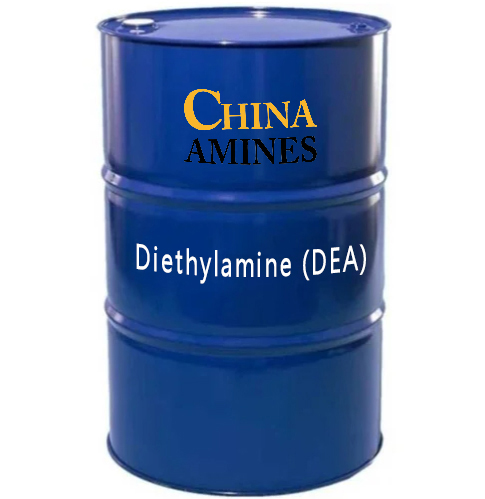Your Questions and Comments
Your sales and customer service desk partners within China Amines Co will continue to serve you. You can also contact us via our headquarter office-
Email:info@chinaamines.com
China Amines Co
Product Profile
1. Chemical Structure and Properties
Molecular Formula:
C₄H₁₁N
Structural Formula:
(CH₂CH₃)₂NH – A secondary aliphatic amine with two ethyl groups bonded to a central nitrogen atom.
Physical Properties:
- Appearance: Colorless to pale yellow liquid with a strong ammonia-like odor.
- Boiling Point: 56°C
- Density: 0.71 g/cm³
- Vapor Pressure: 250 mmHg at 20°C
- Solubility: Miscible with water, ethanol, and most organic solvents.
Chemical Properties:
- Basicity: Strong base (pKa = 10.98 in water), reacts exothermically with acids to form salts (e.g., diethylamine hydrochloride).
- Reactivity: Participates in alkylation, acylation, and condensation reactions; highly flammable (flash point: -23°C).
2. Industrial Applications
Pharmaceuticals:
- Intermediate in synthesizing local anesthetics (e.g., lidocaine) and antihistamines (e.g., diphenhydramine).
Agrochemicals:
- Key precursor for herbicides (e.g., atrazine) and fungicides (e.g., propiconazole).
Rubber Industry:
- Vulcanization accelerator in synthetic rubber production (e.g., neoprene).
Surfactants and Corrosion Inhibitors:
- Produces quaternary ammonium salts for detergents and oilfield chemicals.
Organic Synthesis:
- Catalyst in Grignard reactions and polymerization processes (e.g., polyurethane foams).
3. Safety and Toxicology
Health Hazards:
- Inhalation (≥25 ppm): Severe respiratory irritation, dizziness, and headache (TLV-TWA: 5 ppm).
- Skin Contact: Corrosive burns and dermatitis (rabbit skin LD50: 820 mg/kg).
- Eye Exposure: Permanent corneal damage.
- Ingestion: Highly toxic (oral LD50 rat: 540 mg/kg); causes gastrointestinal necrosis.
Acute Exposure:
- Chronic Effects: Potential liver and kidney damage (observed in animal studies).
Flammability and Explosion Risks:
- Extremely flammable liquid (flammability range: 1.7–10.1% vol in air).
- Reacts violently with oxidizers (e.g., nitric acid) and halogens.
Protection Measures:
- PPE: Neoprene gloves, chemical goggles, and NIOSH-approved respirators.
- Engineering Controls: Explosion-proof ventilation, inert gas blanketing.
4. Environmental and Regulatory Compliance
Environmental Impact:
- Aquatic Toxicity: LC50 (fish, 96h): 50 mg/L; EC50 (daphnia): 20 mg/L.
- Biodegradability: Readily biodegradable (OECD 301D: >70% in 28 days).
- Atmospheric Fate: Reacts with hydroxyl radicals (half-life ~6 hours); contributes to smog formation.
Regulatory Frameworks:
- GB 13690-2009: Listed as Class 3.1 Flammable Liquid and Class 8.2 Corrosive Substance.
- OSHA PEL: 25 ppm (8-hour TWA); EPA TRI: Reportable Quantity (RQ) = 1,000 lbs.
- CLP Regulation: Classified as Flammable Liquid (Category 1), Skin Corr. 1B (H314), and Acute Tox. 3 (H331).
- REACH: Requires SDS with exposure limits and disposal guidelines.
Transportation:
UN Number: UN 1154; Hazard Class: 3 (Flammable Liquid), Packing Group I.
5. Case Studies and Application Insights
Case 1: Lidocaine Synthesis
Process: DEA reacts with 2,6-dimethylaniline to form the intermediate for lidocaine, a widely used local anesthetic.
Efficiency: 85% yield at 60°C with catalytic acid (Pfizer’s optimized batch process).
Case 2: Oilfield Corrosion Inhibition
Application: Schlumberger uses DEA-derived imidazoline surfactants to protect pipelines from H₂S corrosion.
Performance: Reduces corrosion rates by 90% at 50 ppm dosage in acidic environments.
Comparative Analysis:
- Pros: DEA has lower cost and higher reactivity in alkylation reactions.
- Cons: TEA offers better thermal stability (up to 150°C) for high-temperature processes.


